Visit the Pont Neuf in Paris
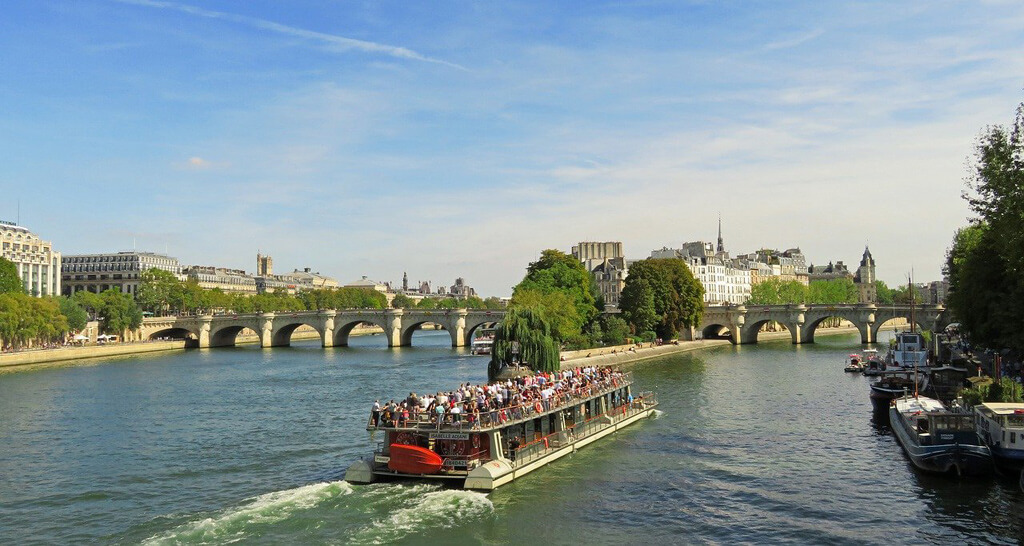
The Pont Neuf is one of the bridges along the Seine River in Paris. With a total length of 232 meters, the Pont Neuf spans the Seine River, and it connects Ile de la Cité to the first and sixth arrondissements.
The Pont Neuf is an institution in Paris, both for its history and beautiful architecture. Since 1889, the Pont Neuf has been listed Historical Monument, a special status in France that guarantees its protection. Since 1991, the bridge is also listed as UNESCO World Heritage together with the Seine River banks.
The Pont-Neuf – ‘New Bridge’ in French –is actually the oldest bridge in Paris, dating back to the early 17th century. With such a long history, it’s no wonder that there are so many curious facts about this beautiful bridge!
Here are 15 of our favorite interesting facts about the Pont Neuf in Paris that you (probably) didn’t know:

The Construction of Pont Neuf Was Key for the City of Paris
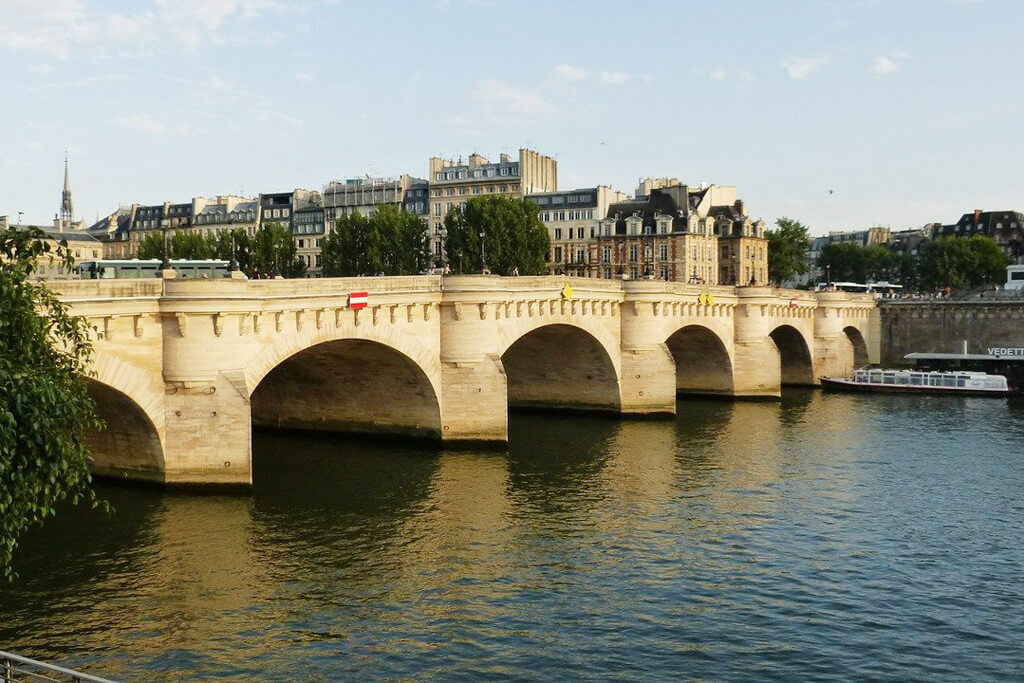
The bridge proved essential to the flow of traffic across Paris. Before the Pont Neuf, getting to the Louvre from the Left Bank was a famously tortuous endeavor that, for all those not wealthy enough to have a boat waiting to ferry them across, required the use of two bridges and a long walk on each side.
The construction of the Pont-Neuf was also necessary to relieve the traffic congestion on the Pont au Change and the Pont of Notre Dame, which threatened to collapse.
The Construction of the Pont Neuf was Paid by Other Provinces
Where to find the funds to build this new stone bridge? The kingdom decided to tax the surrounding provinces of Burgundy, Champagne, Normandy, and Picardy to get the money to construct the Pont Neuf.
The Pont Neuf is Nicknamed Le Pont des Trois Henri (the Three Henry’s Bridge)
The construction of the Pont Neuf lasted more than 50 years. The first project of a bridge to connect the Louvre Royal Palace with the new neighborhoods of Paris was under the reign of King Henri II, around 1545. However, the construction works only started under the reign of King Henri III in 1577, and it was inaugurated by King Henri IV in 1607.
The Pont Neuf Has Two Separate Spans
The Pont Neuf crosses the Seine River by leaning on the Square du Vert Galant. The shortest span (78 m) has five arches and connects the Left Bank to Ile de la Cité. The longest span (154m) has seven arches, and it connects Ile de la Cité to the Right Bank.
The Pont Neuf Was an Innovative Bridge
The Pont Neuf was the first bridge to cross the Seine entirely. Before the construction of the Pont Neuf, the Parisian bridges were mainly made of wood and were lined on both sides with houses, but most of them collapsed.
The Pont-Neuf was the first bridge to be built in stone and without houses on it. It was also the only bridge from which the people could see the Seine River: a real change for the time! Pont Neuf was also the first bridge in Paris to propose sidewalks for pedestrians. Its name, which distinguished it from the old bridges in wood and with houses, simply stuck.
Le Pont Neuf était un vaste promenoir à l’air libre, généreusement doté de trottoirs et ouvert sur la Seine, ça c’était très nouveau.
Pont Neuf is the Third Longest Bridge in Paris
Pont Neuf is only beaten by the Pont Aval du Périphérique (312 m) in Paris 16 and Pont Amont du Périphérique (270 m) in Paris 13. Boulevard Périphérique is the (infamous) ring road around Paris.
The Pont Neuf’s Design is Reminiscent of Roman Architecture
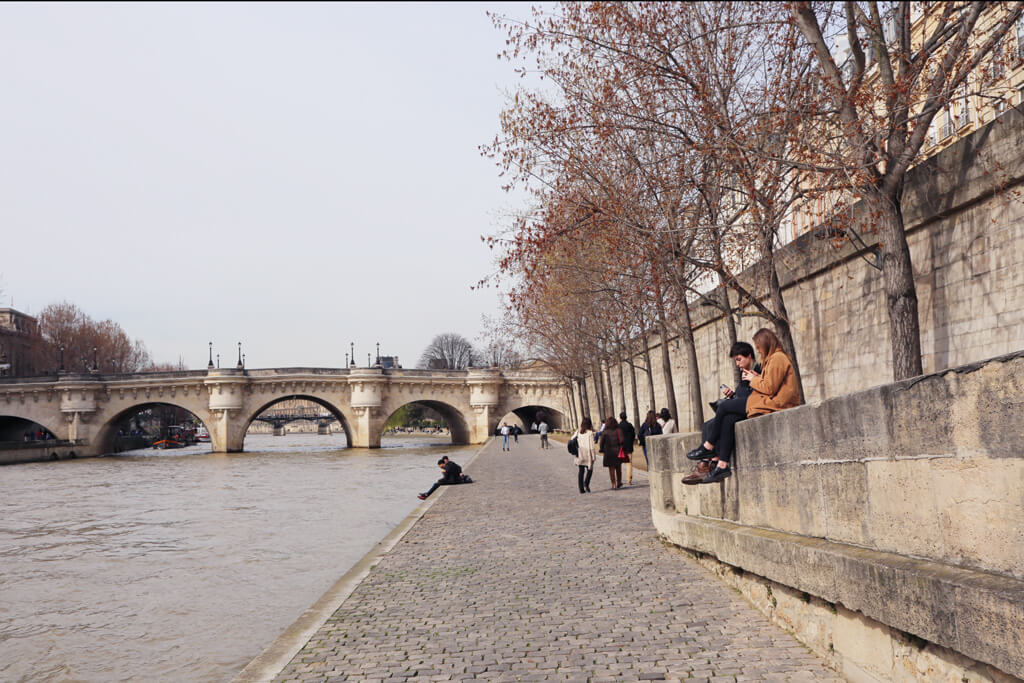
The design of the Pont Neuf and the arches that support it are reminiscent of earlier Roman structures. The bridge’s sidewalks for pedestrians were inspired by the Roman roads.
The Pont Neuf sidewalks were the first the world had seen since Roman roads and something that people had never seen in a Western city!
Another curious fact about these sidewalks is that nobody knew how to call the people who used them. On some official documents, we can read the expression ‘gens de pied,’ meaning ‘people on foot.’
King Henri IV Watches over the Bridge
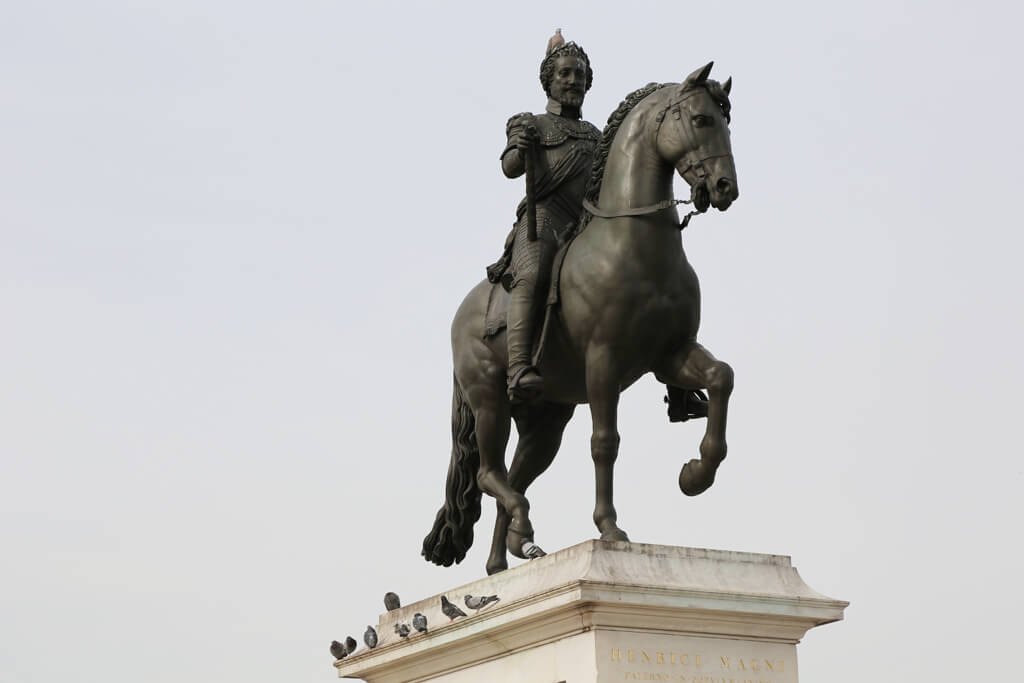
Pont Neuf has the statue King Henri IV. This was the first equestrian statue erected in Paris and also the first statue free-standing, not related to any building.
Like other royal statues, King Henri IV was melted down during the French Revolution. It was replaced by a replica in 1818 during the Restoration.
The legend says ha the sculptor of this new statue was a Bonapartist, who would have hidden anti-royalist pamphlets inside!
To kill the rumors, in 2004, the city decided to open the statue. Inside the belly of the horse, the workers found 7 boxes containing documents related to the inauguration of the statue, or about the King, and some medals. They also found some scrolls belonging to the sculptor, which unfortunately could not be deciphered. Mystery UNsolved!
The Pont Neuf’s Mascarons
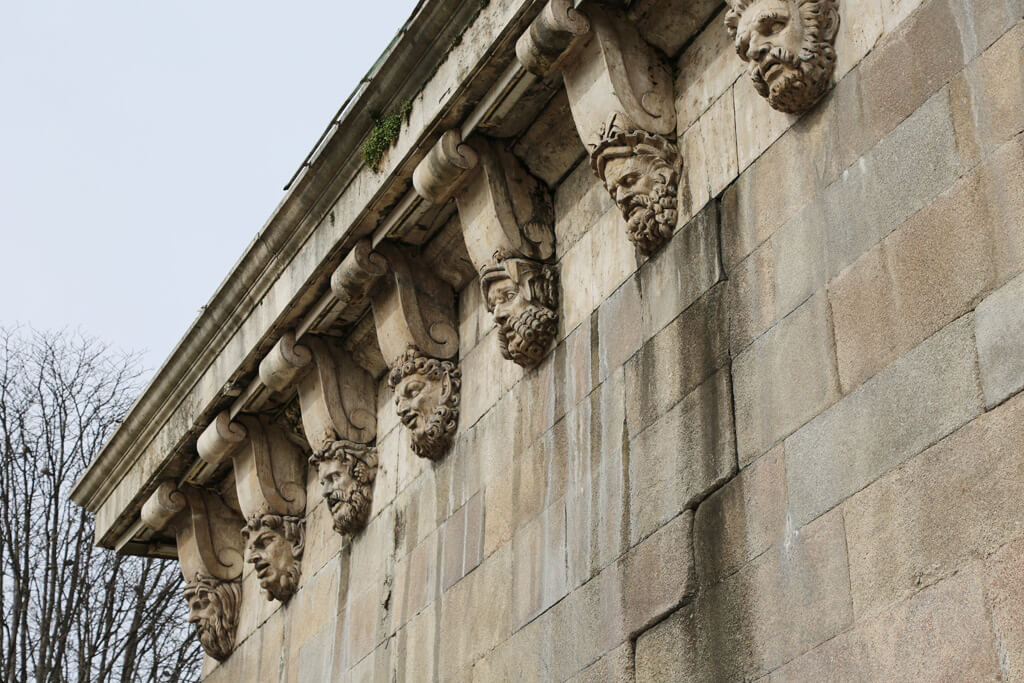
The bridge moldings are decorated with a total of 385 mascarons (grimacing stone faces), all different. There’s a fun urban legend about King Henri IV and the Pont Neuf’s mascarons. Here’s the story:
King Henri IV was nicknamed Le Vert Galant (a French expression meaning ‘the old gallant) because of his liking for women even after a certain age. The legend says that the mascarons are the faces of the cheated husbands, more than 300! And there’s even the face of a woman!
The mascarons of the Pont Neuf are replicas. You can find some originals at the Musée Carnavalet. Each face weighs more than 100 kg!
The Pont Neuf was a ‘Shopping Bridge’

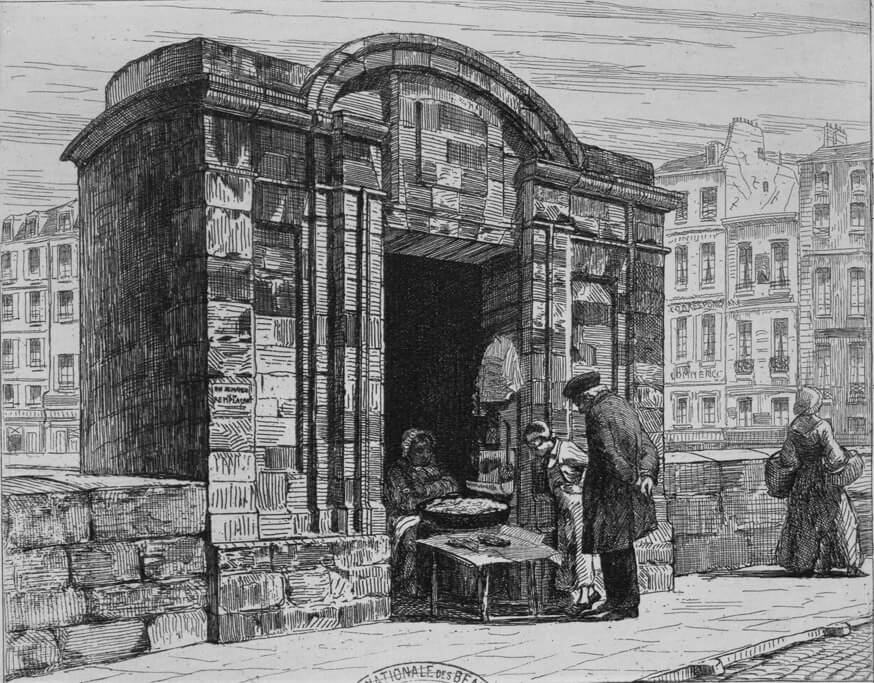
From 1619, street vendors spread their stalls in the half-moon turrets on both sides of the bridge. Over the years, more durable shops emerged.
In 1775, J.G. Soufflot designed twenty new shops on the hemicycles: notion stores, printers, shoe shiners, dog clippers, toy sellers, phosphor lighters, etc., and settled on the Pont Neuf. Apart from these shops, there were also stalls offering waffles, donuts, and more. The last shops disappeared in 1855.
Pont Neuf was Home to the First Bouquinistes
The first bouquinistes settled on Pont Neuf in the middle of the 17th century.
A quarrel opposed the bouquinistes to the neighborhood booksellers who saw in them a thread for their businesses. The booksellers managed to ban the bouquinistes thanks to a royal decree published in 1742.
It took two centuries for the bouquinistes to be able to settle again near the Seine, along the quays where we can still see them.
Pont Neuf was also Home to Gangsters
During the 18th century, the bridge was considered the heart of the city. It was a spot for many street performers and merchants, and it was always lively and busy.
Unfortunately, Pont Neuf was also a spot for crime. Before the completion of the bridge, gangsters and hooligans would hide under and around the site to prey on victims.
The Pont Neuf was Home to a Crocrodrile
In 1984, the Paris sewer workers working under the Pont-Neuf came face to face with an animal 75 cm long, crouching in the dark … It was a real Nile crocodile!
Captured by the firefighters of Paris, the beast found a new home first at Jardin des Plantes in Paris, and then it was moved to the Aquarium of Vannes. Named Eleanore, she is now 3 meters long and weighs 200 kg. So if you go to Brittany, you can visit her!
Some French Expressions are Inspired by the Pont Neuf
When the Pont-Neuf was inaugurated, it was a total attraction for Parisians who liked to sing on the Pont Neuf! This is how the expression ‘a Pont-Neuf’ was born to describe something or somebody with a popular air, known by everybody.
Because the bridge is very solid and has resisted many floods, there’s also the expression, ‘to be like a Pont Neuf’ to describe people with solid health.
Pont Neuf was the French Fries’ Birthplace
According to historians, the French fries would come… from the French capital. Indeed, the Pommes du Pont Neuf (‘Pont Neuf fried potatoes’) would have been invented by street vendors on the oldest bridge in Paris after the Revolution of 1789. These fried potatoes were cut into slices and cooked in lard or butter.
What to Do Near the Pont Neuf in Paris?
- Square du Vert Galant – Place Dauphine
- Louvre Museum
- Monnaie de Paris
- Sainte Chapelle
- Conciergerie
- Seine River Cruise

